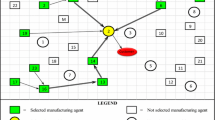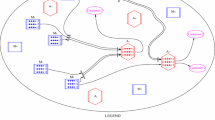Abstract
Virtual computer-integrated manufacturing (VCIM) is a promising manufacturing strategy in today’s global market because it is capable of exploiting distributed resources effectively, both locally as well as globally. Resource scheduling is critical to the operation of VCIM systems. In this article, a novel model for resource scheduling in VCIM systems is developed. By integrating collaborative transportation scheduling into manufacturing resource scheduling, the proposed model can provide a better solution because of reduction in the fixed transportation cost. Performance of the developed model is verified by computer simulation for a case study producing computer hard disks. The proposed model serves as a fundamental step towards global optimisation of VCIM systems.





Similar content being viewed by others
References
Asawasakulsorn A (2009) Transportation collaboration: partner selection criteria and IOS design issues for supporting trust. Int J Bus Inf 4(2):199–220
Batur GD, Karasan OE, Akturk MS (2012) Multiple part-type scheduling in flexible robotic cells. Int J Prod Econ 135(2):726–740
Cardin O, Mebarki N, Pinot G (2013) A study of the robustness of the group scheduling method using an emulation of a complex FMS. Int J Prod Econ 146(1):199–207
Chan FTS, Zhang T (2011) The impact of collaborative transportation management on supply chain performance: a simulation approach. Expert Syst Appl 38(3):2319–2329
Dai B, Chen H (2009) Mathematical model and solution approach for collaborative logistics in less than truckload (LTL) transportation. In: International conference on computers and industrial engineering, Troyes, France, pp 767–772
Dao SD, Abhary K, Marian R (2012) Optimisation of resource scheduling in VCIM systems using genetic algorithm. Int J Adv Res Artif Intell 1(8):49–56
Ergun Ö, Kuyzu G, Savelsbergh M (2007) Shipper collaboration. Comput Oper Res 34(6):1551–1560
Harrington J (1973) Computer integrated manufacturing. Industrial Press, New York
He N, Zhang DZ, Li Q (2014) Agent-based hierarchical production planning and scheduling in make-to-order manufacturing system. Int J Prod Econ 149:117–130
Lair NAM (2008) An integrated model for optimising manufacturing and distribution network scheduling. Ph.D. thesis, School of Advance Manufacturing and Mechanical Engineering, University of South Australia
Li J, Chan FTS (2012) The impact of collaborative transportation management on demand disruption of manufacturing supply chains. Int J Prod Res 50(19):5635–5650
Lin GCI (1997) The latest research trends in CIM. Keynote paper. In: The fourth international conference on computer integrated manufacturing, Singapore, pp 26–33
Miller FP, Vandome AF, McBrewster J (2010) Computer-integrated manufacturing. VDM Publishing House, Port Louis
Nagalingam SV, Lin GCI (1999) Latest developments in CIM. Robot Comput Integr Manuf 15(6):423–430
Nagalingam SV, Lin GCI, Wang D (2007) Resource scheduling for a virtual CIM system. In: Wang L, Shen W (eds) Process planning and scheduling for distributed manufacturing. Springer, London, pp 269–294
Ozener OO (2008) Collaboration in transportation. Ph.D. thesis, Georgia Institute of Technology, Atlanta, GA, USA
Sawik T (2007) A lexicographic approach to bi-objective scheduling of single-period orders in make-to-order manufacturing. Eur J Oper Res 180(3):1060–1075
Wang D (2007) The development of an agent-based architecture for virtual CIM. Ph.D. thesis, University of South Australia, Adelaide, Australia
Wang D, Nagalingam SV, Lin GCI (2003) Development of an optimised virtual CIM system. In: The 17th international conference on production research, Blacksburg, VA, USA, pp 1–5
Wang D, Nagalingam SV, Ln GCI (2004) Production and logistic planning towards agent-based virtual CIM system in an SME network. In: Eighth international conference on manufacturing and management, QLD, Australia, pp 1–8
Wang D, Nagalingam SV, Lin GCI (2005) A novel multi-agent architecture for a virtual CIM system. Int J Agile Manuf 8(1):69–81
Wang D, Nagalingam SV, Lin GCI (2007) Development of an agent-based virtual CIM architecture for small to medium manufacturers. Robot Comput Integr Manuf 23(1):1–16
Zhou N, Nagalingam SV, Lin GCI (2007) Application of virtual CIM in small and medium manufacturing enterprises. In: Hinduja S, Fan K-C (eds) The 35th international MATADOR conference, Springer, London, pp 161–164
Zhou N, Xing K, Nagalingam SV (2010a) An agent-based cross-enterprise resource planning for small and medium enterprises. IAENG Int J Comput Sci 37(3):1–7
Zhou N, Xing K, Nagalingam SV, Lin GCI (2010b) Development of an agent based VCIM resource scheduling process for small and medium enterprises. In: International multiconference of engineers and computer scientists, Hong Kong, pp 39–44
Zhou N, Nagalingam SV, Xing K, Lin GCI (2011) Inside virtual CIM: multi-agent based resource integration for small to medium sized manufacturing enterprises. In: Ao S-I, Castillo O, Huang X (eds) Intelligent control and computer engineering, vol 70. Springer, Dordrecht, pp 163–175
Acknowledgments
The first author is grateful to Australian Government for sponsoring his PhD study at University of South Australia, Australia in form of Endeavour Award.
Author information
Authors and Affiliations
Corresponding author
Rights and permissions
About this article
Cite this article
Dao, S.D., Abhary, K. & Marian, R. An innovative model for resource scheduling in VCIM systems. Oper Res Int J 18, 33–54 (2018). https://doi.org/10.1007/s12351-016-0252-y
Received:
Revised:
Accepted:
Published:
Issue Date:
DOI: https://doi.org/10.1007/s12351-016-0252-y




